The Stress-Relief Skincare Market is expected to record a valuation of USD 2,901.5 million in 2025 and USD 6,403.8 million in 2035, with an increase of USD 3,502.3 million, which equals a growth of 193% over the decade. The overall expansion represents a CAGR of 8.2% and a nearly 2X increase in market size.
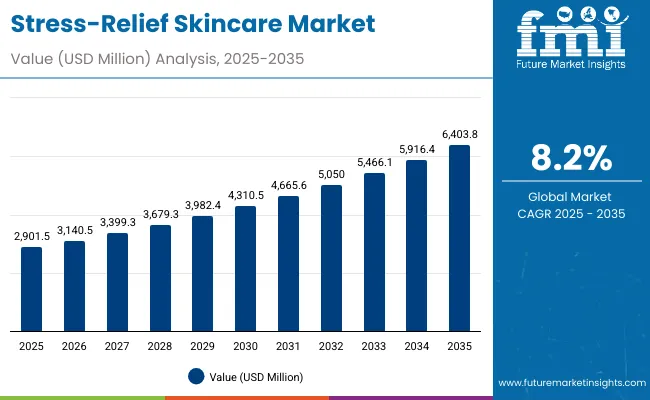
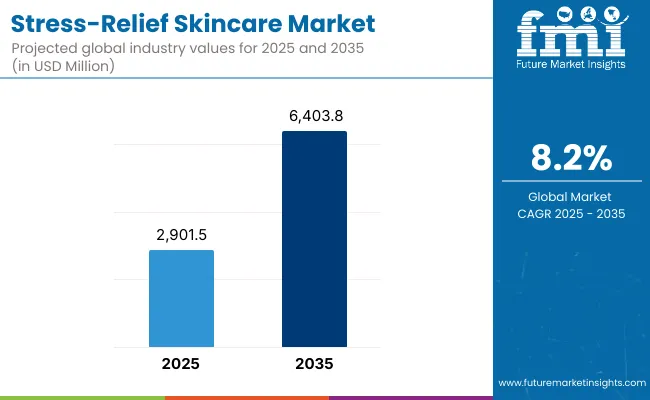
Stress-Relief Skincare Market Key Takeaways
| Metric | Value |
|---|---|
| Stress-Relief Skincare Market Estimated Value (2025E) | USD 2,901.5 million |
| Stress-Relief Skincare Market Forecast Value (2035F) | USD 6,403.8 million |
| Forecast CAGR (2025 to 2035) | 8.2% |
During the first five-year period from 2025 to 2030, the market increases from USD 2,901.5 million to USD 4,310.5 million, adding USD 1,409.0 million, which accounts for 40% of the total decade growth. This phase records steady adoption across wellness-driven skincare routines, aromatherapy-infused formulations, and stress-balancing topicals, driven by rising consumer focus on relaxation and mental well-being. Creams & lotions dominate this period as they cater to over 44% of the segment, appealing to users seeking hydration and soothing sensory effects.
The second half from 2030 to 2035 contributes USD 2,093.3 million, equal to 60% of total growth, as the market jumps from USD 4,310.5 million to USD 6,403.8 million. This acceleration is powered by the widespread adoption of adaptogen-enriched products, vitamin-based actives, and neurocosmetic formulations in premium skincare portfolios.
Oils and balms together capture a larger share above 55% by the end of the decade. Ingredient-led innovation and clean-label trends expand the natural extract segment’s share beyond 60% in total value.
From 2020 to 2024, the Stress-Relief Skincare Market grew steadily driven by increasing adoption of aromatherapy-infused and vitamin-based formulations for emotional well-being and skin health. During this period, the competitive landscape was dominated by cream and oil manufacturers controlling nearly 90% of revenue, with leaders such as Bio-Oil and Palmer’s expanding their botanical and clean-label portfolios. Competitive differentiation relied on texture innovation, natural ingredients, and brand trust, while functional serums and balms remained a niche segment with less than 10% market share.
Demand for stress-relief skincare is expected to reach USD 2,901.5 million in 2025, with the revenue mix gradually shifting toward natural actives and neuro-cosmetic ingredients. By 2035, the market will expand to USD 6,403.8 million, driven by AI-inspired formulation development, sensorial customization, and data-driven skincare solutions.
Traditional cream and oil brands face competition from digital-first cosmetic players offering personalized stress-relief solutions through subscription and smart-diagnostic platforms. The competitive advantage is shifting from product innovation alone to ecosystem strength, scalability, and consistent consumer engagement through wellness-based positioning.
The growing global prevalence of stress-induced skin issues such as inflammation, dullness, and premature aging is a major growth catalyst. Consumers are increasingly aware of the skin-mind connection, driving demand for formulations containing adaptogens, essential oils, and calming botanical extracts.
Brands are focusing on neurocosmetic innovations that help reduce cortisol-induced skin damage and improve sensory relaxation. This holistic approach to wellness-oriented skincare is fueling steady expansion across premium and mass-market product lines worldwide.
The surge in wellness-centric lifestyles has redefined skincare as part of emotional and psychological well-being. Consumers, especially millennials and Gen Z, are investing in stress-relief skincare products that combine aromatherapy, hydration, and mood-boosting ingredients.
The integration of spa-grade experiences into daily routines, supported by social media influence and digital self-care movements, is accelerating product adoption. This alignment between personal wellness and skincare efficacy is strengthening brand differentiation and driving consistent category growth globally.
The Stress-Relief Skincare Market is segmented by product type, key ingredients, user group, distribution channel, and region. Product types include creams & lotions, oils, balms, and serum concentrates, forming the core of stress-relief skincare adoption. Key ingredients comprise Vitamin E, cocoa butter, shea butter, Centella asiatica, and hyaluronic acid, offering hydration, barrier repair, and calming properties.
By user group, segmentation includes pregnant women, post-partum mothers, weight-loss/stretching individuals, and athletes/bodybuilders. Distribution channels encompass pharmacies & drugstores, e-commerce, specialty beauty retail, and supermarkets & hypermarkets. Regionally, the market covers North America, Europe, East Asia, South Asia & Pacific, Latin America, and the Middle East & Africa, with the USA, China, India, Japan, Germany, and the UK representing the most dynamic growth markets.
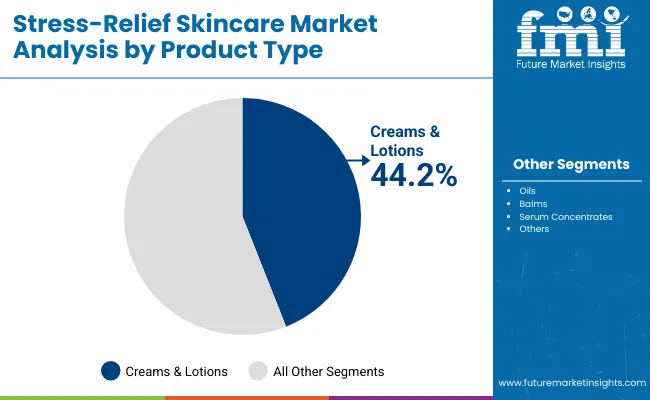
| Product Type | Value Share % 2025 |
|---|---|
| Creams & lotions | 44.2% |
| Others | 55.8% |
The creams & lotions segment is projected to contribute 44.2% of the Stress-Relief Skincare Market revenue in 2025, maintaining its lead as the dominant product category. This growth is driven by the rising preference for lightweight, fast-absorbing formulations that combine hydration with soothing aromatherapeutic benefits.
Consumers increasingly favor multifunctional creams that relieve tension, reduce redness, and restore skin balance caused by stress exposure. The segment’s momentum is further supported by clean-label innovation, inclusion of adaptogenic botanicals, and neuro-calming actives that promote relaxation. As emotional wellness continues to influence beauty routines, creams & lotions are expected to remain the foundation of stress-relief skincare offerings.
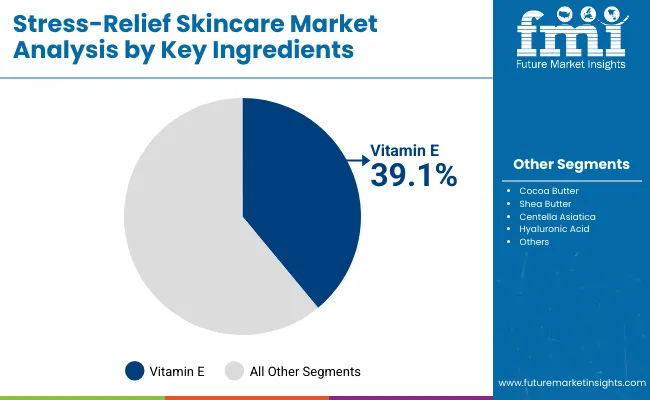
| Key Ingredients | Value Share % 2025 |
|---|---|
| Vitamin E | 39.1% |
| Others | 60.9% |
The Vitamin E segment is forecasted to hold 39.1% of the Stress-Relief Skincare Market share in 2025, led by its extensive application in formulations designed to combat oxidative stress and improve skin resilience. Vitamin E-enriched products are favored for their antioxidant, moisturizing, and barrier-repairing properties, making them a core component in creams, lotions, and serums aimed at reducing the visible impact of stress on skin.
Its wide compatibility with botanical oils and natural butters enhances sensory appeal and efficacy. Growing consumer awareness of ingredient transparency and dermatological safety continues to reinforce Vitamin E’s dominance, as brands emphasize skin restoration, radiance, and overall wellness through antioxidant-driven formulations.
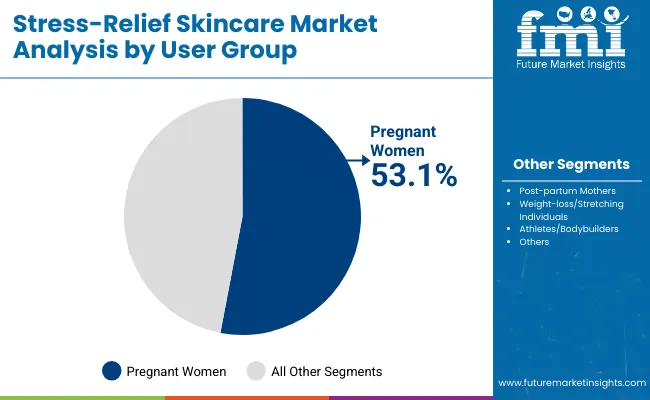
| User Group | Value Share % 2025 |
|---|---|
| Pregnant women | 53.1% |
| Others | 46.9% |
The pregnant women segment is projected to account for 53.1% of the Stress-Relief Skincare Market revenue in 2025, establishing it as the leading user group. This dominance is attributed to the rising emphasis on preventive skincare during pregnancy, where hormonal fluctuations and heightened skin sensitivity drive demand for gentle, stress-calming formulations. Products containing natural emollients, Vitamin E, cocoa butter, and Centella asiatica are particularly preferred for their soothing and restorative benefits.
The segment’s growth is further supported by increasing awareness of mental well-being and relaxation-based self-care routines during maternity. As consumers prioritize safe, non-toxic, and dermatologically tested solutions, pregnant women are expected to remain the primary end-user group in the stress-relief skincare market through 2035.
Rising Prevalence of Stress-Induced Skin Disorders
Growing global stress levels have intensified issues such as inflammation, dullness, and premature aging, directly boosting the demand for stress-relief skincare. Consumers are increasingly turning toward neurocosmetic formulations that target the skin-mind connection through adaptogens, essential oils, and vitamin complexes.
This shift is further amplified by urban lifestyles, long work hours, and digital fatigue, all contributing to skin barrier disruption. As awareness of the psychological impact on skin health increases, brands are expanding their portfolios with calming, antioxidant-rich products designed to restore both skin balance and emotional well-being.
Surge in Wellness-Centric and Self-Care Beauty Routines
The integration of mental wellness into beauty routines is a key growth catalyst for the stress-relief skincare market. Consumers, especially millennials and Gen Z, associate skincare with emotional decompression and self-pampering. The demand for sensorial, spa-like experiences has accelerated innovation in aromatherapy-infused products and neuro-soothing ingredients.
Brands are positioning their products as holistic wellness solutions rather than cosmetic fixes, emphasizing hydration, relaxation, and mood enhancement. This convergence of skincare and wellness is creating strong momentum for premium and natural formulations that deliver both functional and therapeutic benefits in daily use.
High Product Cost and Limited Ingredient Validation
Despite strong consumer interest, the premium pricing of stress-relief skincare products remains a challenge, especially in price-sensitive markets. Formulations incorporating adaptogens, exotic botanical oils, and neuroactive ingredients increase production costs, which limits accessibility among mid-income consumers.
Additionally, clinical validation for many stress-relief claims is still limited, making it difficult for brands to substantiate efficacy in regulatory terms. This lack of standardized testing and high formulation expenses can restrict product scalability, slow mainstream adoption, and reduce consumer trust, especially when competitors offer conventional moisturizers with lower price points.
Emergence of Neurocosmetics and Sensorial Formulations
A major trend reshaping the stress-relief skincare market is the rise of neurocosmetics formulations designed to influence skin-brain communication. These products combine active ingredients like peptides, adaptogens, and essential oils that interact with sensory receptors, enhancing mood and reducing stress responses.
Brands are incorporating soft textures, mood-lifting scents, and cooling sensations to create a multisensory skincare experience. This trend also aligns with digital wellness, as consumers seek stress-mitigating rituals to counteract blue light and mental fatigue. The convergence of neuroscience and skincare science is defining the next generation of wellness-driven beauty innovation.
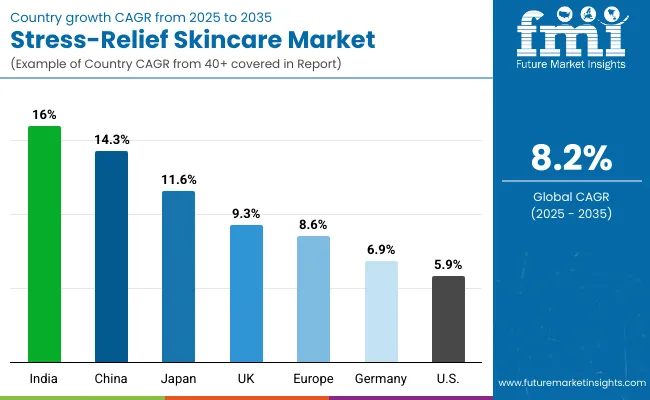
| Country | Estimated CAGR (2025 to 2035) |
|---|---|
| China | 14.3% |
| USA | 5.9% |
| India | 16.0% |
| UK | 9.3% |
| Germany | 6.9% |
| Japan | 11.6% |
The global Stress-Relief Skincare Market exhibits clear regional variations in adoption and growth, largely influenced by consumer wellness awareness, spending capacity, and local beauty culture. Asia-Pacific leads growth, with India (16.0%) and China (14.3%) emerging as the fastest-expanding markets.
This surge is driven by rising disposable incomes, urban stress levels, and rapid adoption of herbal and ayurvedic skincare traditions integrated with modern cosmetic science. Japan (11.6%) also shows robust progress, fueled by innovation in neurocosmetic formulations and a preference for minimal, sensory-rich self-care routines.
Europe demonstrates strong performance, with the UK (9.3%) and Germany (6.9%) benefiting from high consumer awareness of clean-label and sustainable skincare. European brands continue to lead in formulating plant-based and aromatherapy-driven products backed by dermatological research. The focus on mental wellness, coupled with premiumization trends, reinforces Europe’s steady growth outlook.
In North America, the USA (5.9%) shows moderate expansion due to market maturity and product saturation. Growth here is service-led, with increasing adoption of data-backed skincare analytics, AI personalization, and subscription-based wellness offerings. Overall, Asia-Pacific remains the powerhouse for stress-relief skincare, combining traditional botanicals with advanced formulation technologies to drive the next phase of global market expansion.
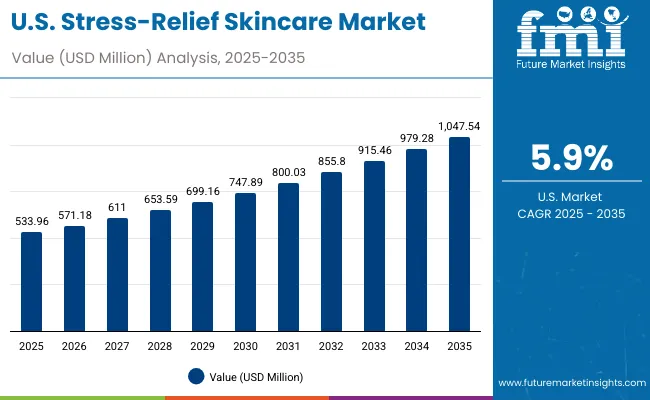
| Year | USA Stretch Mark Prevention Creams Market (USD Million) |
|---|---|
| 2025 | 533.96 |
| 2026 | 571.18 |
| 2027 | 611.00 |
| 2028 | 653.59 |
| 2029 | 699.16 |
| 2030 | 747.89 |
| 2031 | 800.03 |
| 2032 | 855.80 |
| 2033 | 915.46 |
| 2034 | 979.28 |
| 2035 | 1047.54 |
The Stress-Relief Skincare Market in the United States is projected to grow at a CAGR of 5.9%, driven by a rising focus on wellness-oriented skincare and holistic self-care routines. Growth is supported by increasing adoption of mood-enhancing, aromatherapy-based formulations targeting stress-induced skin concerns such as dullness, fatigue, and barrier damage. Premium brands are expanding into neurocosmetic product lines integrating calming botanicals, adaptogens, and Vitamin E to enhance the skin-mind connection.
E-commerce channels continue to dominate, with USA consumers favoring customized skincare regimes supported by AI-driven diagnostics and subscription models. Retail pharmacies and wellness stores are witnessing higher footfall as stress management becomes part of preventive skincare. Product innovation focusing on clean, dermatologically tested ingredients and sustainable packaging is further strengthening brand differentiation and consumer loyalty.
The Stress-Relief Skincare Market in the United Kingdom is expected to grow at a CAGR of 9.3%, driven by rising consumer interest in wellness-integrated skincare and premium aromatherapeutic formulations. British consumers are increasingly adopting skincare routines that combine mindfulness with dermatological care, prioritizing products containing adaptogens, essential oils, and vitamin-rich antioxidants. The market is witnessing strong traction for clean-label and cruelty-free brands, supported by eco-conscious purchasing habits and regulatory emphasis on sustainable formulations.
Retailers are expanding shelf space for stress-relief skincare, while online platforms are leveraging AI to recommend mood-specific routines. The wellness tourism and spa sector is also promoting locally produced, therapeutic skincare solutions, amplifying domestic brand presence. The combination of strong R&D in cosmetic chemistry, government-backed clean beauty initiatives, and collaboration between wellness brands and dermatological clinics continues to fuel market expansion.
India is witnessing rapid growth in the Stress-Relief Skincare Market, which is forecast to expand at a CAGR of 16.0% through 2035. The surge is driven by increasing consumer awareness of stress-related skin issues and a cultural shift toward holistic wellness and Ayurveda-based skincare.
Tier-2 and tier-3 cities are emerging as high-growth zones, supported by rising disposable incomes, exposure to digital wellness trends, and expanding retail penetration. Domestic and international brands are launching cost-effective, herbal-based stress-relief creams, oils, and balms tailored to Indian skin types and climatic conditions.
The country’s dynamic beauty and wellness industry, combined with growing participation from dermatologists and spa operators, is propelling product innovation. Ayurvedic ingredients such as ashwagandha, sandalwood, and turmeric are being integrated into modern neurocosmetic formulations, appealing to both traditional and modern consumers.
The Stress-Relief Skincare Market in China is expected to grow at a CAGR of 14.3%, the highest among leading economies. This strong momentum is driven by rising disposable incomes, an expanding middle-class population, and the increasing normalization of wellness-based skincare routines.
Consumers are prioritizing skin-mind balance, driving high demand for calming, hydrating, and aromatherapy-infused products. Local brands are rapidly innovating with traditional Chinese herbal actives such as ginseng, goji berry, and green tea, integrated into modern neurocosmetic formulations that address both stress and environmental skin damage.
E-commerce remains the key growth lever, with Chinese digital platforms such as Tmall and JD.com promoting personalized skincare subscriptions and live-streaming beauty consultations. Urban wellness trends, combined with younger consumers’ preference for holistic beauty and self-care rituals, are expanding the premium and clean-label product segments.
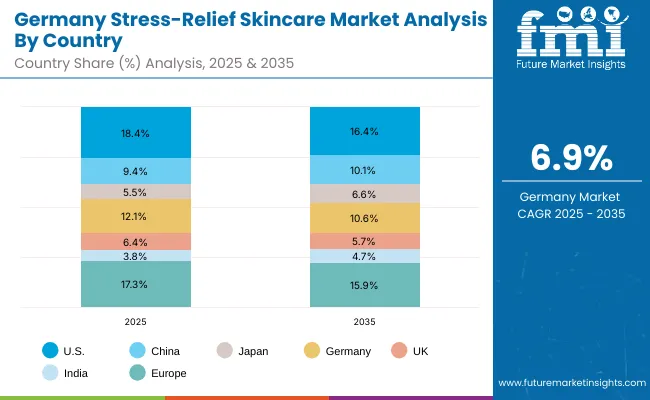
| Country | 2025 Share (%) |
|---|---|
| USA | 18.4% |
| China | 9.4% |
| Japan | 5.5% |
| Germany | 12.1% |
| UK | 6.4% |
| India | 3.8% |
| Country | 2035 Share (%) |
|---|---|
| USA | 16.4% |
| China | 10.1% |
| Japan | 6.6% |
| Germany | 10.6% |
| UK | 5.7% |
| India | 4.7% |
The Stress-Relief Skincare Market in Germany is projected to grow at a CAGR of 6.9%, supported by the country’s advanced cosmetic manufacturing base, stringent quality standards, and rising consumer awareness of skin-mind wellness. German consumers value dermatologically tested, science-backed formulations that combine functionality with sensory appeal.
Brands are emphasizing precision in formulation balancing active ingredients such as Vitamin E, hyaluronic acid, and Centella asiatica with natural botanicals that promote relaxation and stress relief. The preference for clinically validated, hypoallergenic, and sustainably sourced ingredients reinforces Germany’s strong position in the European skincare market.
The market is also witnessing innovation in functional skincare laboratories integrating neuroscience and biotechnology to study the physiological effects of stress on skin. Premium and pharmacy-led brands are launching neuro-calming serums and moisturizers targeted at urban consumers exposed to pollution and occupational stress. The expansion of e-commerce, alongside strong offline presence in apothecaries and wellness clinics, ensures balanced market coverage.
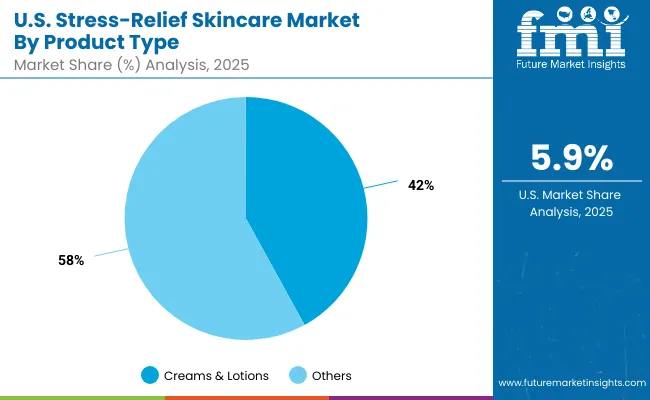
| USA By Product Type | Value Share % 2025 |
|---|---|
| Creams & lotions | 41.8% |
| Others | 58.2% |
The Stress-Relief Skincare Market in the United States is projected at USD 533.96 million in 2025, led by strong consumer preference for multifunctional creams and lotions. The category continues to dominate as consumers seek hydration, stress reduction, and barrier repair benefits from daily-use formulations. Oils and balms, categorized under “others,” are also expanding rapidly due to growing interest in aromatherapy-based relaxation and clean-label beauty solutions.
The shift toward personalized and neurocosmetic skincare is driving a technological transition, where AI-powered diagnostic apps and virtual consultations are redefining consumer engagement. Digital skincare ecosystems that integrate behavioral data, stress profiling, and product customization are becoming central to USA market growth.
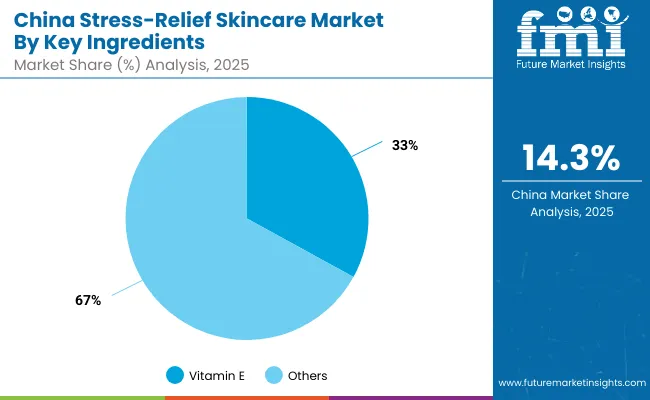
| China By Key Ingredients | Value Share % 2025 |
|---|---|
| Vitamin E | 32.8% |
| Others | 67.2% |
The Stress-Relief Skincare Market in China is valued at USD 89.52 million (Vitamin E-based) and USD 183.40 million (other ingredients) in 2025, reflecting the country’s strong inclination toward natural, functional, and sensorial skincare solutions. The dominance of the “others” segment stems from the extensive use of traditional Chinese herbs, plant oils, and adaptogenic extracts like ginseng, green tea, and goji berry, which resonate with local wellness culture and TCM principles.
The growing convergence of science-backed neurocosmetics and traditional formulations is opening new opportunities for premiumization. Brands are introducing multi-sensory skincare ranges that relieve stress while improving texture, tone, and elasticity. Rising adoption of e-commerce, influencer-led beauty education, and cross-border imports is accelerating consumer exposure to global wellness trends.
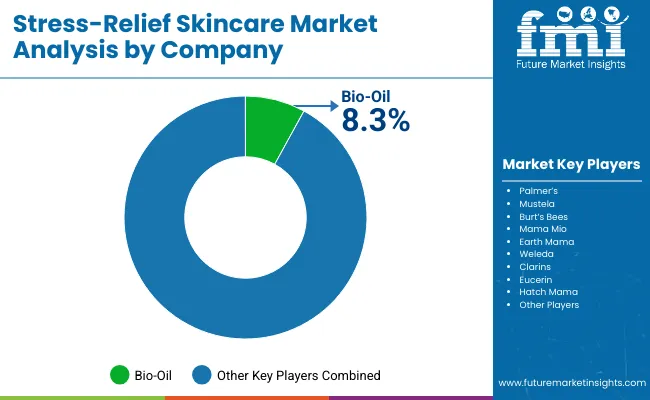
| Company | Global Value Share 2025 |
|---|---|
| Bio-Oil | 8.3% |
| Others | 91.7% |
The Stress-Relief Skincare Market is moderately fragmented, comprising global beauty conglomerates, premium wellness brands, and niche botanical specialists competing across therapeutic and cosmetic segments. Leading brands such as Bio-Oil, Palmer’s, and Clarins hold a notable share, driven by strong brand equity, diversified product portfolios, and consistent innovation in skin-restorative and stress-calming formulations. Their strategies emphasize clinical validation, neurocosmetic research, and clean-label product expansion aligned with evolving wellness preferences.
Mid-sized players such as Burt’s Bees, Mama Mio, Mustela, and Weleda focus on aromatherapy-based skincare, promoting natural actives like cocoa butter, shea butter, and essential oils. Their strength lies in transparent sourcing, eco-friendly packaging, and brand positioning around holistic well-being.
Emerging niche brandsincluding Earth Mama, Eucerin, and Hatch Mamaare rapidly gaining ground through pregnancy-safe, dermatologically tested formulations. Their agility in addressing micro-segments like postpartum care and hormonal stress skincare gives them a competitive edge.
Competitive differentiation is now shifting from ingredient innovation to ecosystem-driven wellness, where brands combine sensorial experience, digital engagement, and emotional well-being. Personalized product recommendations, AI-driven skin diagnostics, and subscription models are emerging as key enablers of brand loyalty and long-term consumer retention.
Key Developments in Stress-Relief Skincare Market
| Item | Value |
|---|---|
| Quantitative Units | USD 2,901.5 Million |
| Product Type | Creams & lotions, Oils, Balms, Serum concentrates |
| Key Ingredients | Vitamin E, Cocoa butter, Shea butter, Centella asiatica, Hyaluronic acid |
| User Group | Pregnant women, Post-partum mothers, Weight-loss/stretching individuals, Athletes/bodybuilders |
| Channel | Pharmacies & drugstores, E-commerce, Specialty beauty retail, Supermarkets & hypermarkets |
| Regions Covered | North America, Europe, Asia-Pacific, Latin America, Middle East & Africa |
| Country Covered | United States, Canada, Germany, France, United Kingdom, China, Japan, India, Brazil, South Africa |
| Key Companies Profiled | Bio-Oil, Palmer’s, Mustela, Burt’s Bees, Mama Mio, Earth Mama, Weleda, Clarins, Eucerin, Hatch Mama |
| Additional Attributes | Dollar sales by product type and ingredient composition, adoption trends in aromatherapy-infused and neurocosmetic skincare, rising demand for portable and multi-sensory skincare formats, segment-specific growth across wellness, maternity, and premium beauty categories, revenue segmentation by offline retail and digital platforms, integration with AI-based skin diagnostics and personalized self-care apps, regional trends shaped by clean beauty movements and wellness tourism, and innovations in formulation science involving adaptogens, Vitamin E complexes, hyaluronic acid blends, and Centella asiatica for stress-calming and restorative skin benefits. |
The global Stress-Relief Skincare Market is estimated to be valued at USD 2,901.5 million in 2025.
The market size for the Stress-Relief Skincare Market is projected to reach USD 6,403.8 million by 2035.
The Stress-Relief Skincare Market is expected to grow at a 8.2% CAGR between 2025 and 2035.
The key product types in the Stress-Relief Skincare Market are creams & lotions, oils, balms, and serum concentrates, each formulated to deliver calming, moisturizing, and restorative benefits for stress-affected skin.
In terms of formulation range, creams & lotions are projected to command the largest share of the Stress-Relief Skincare Market in 2025, driven by their widespread use in daily skincare routines and high consumer preference for soothing, fast-absorbing stress-relief formulations.






Our Research Products

The "Full Research Suite" delivers actionable market intel, deep dives on markets or technologies, so clients act faster, cut risk, and unlock growth.

The Leaderboard benchmarks and ranks top vendors, classifying them as Established Leaders, Leading Challengers, or Disruptors & Challengers.

Locates where complements amplify value and substitutes erode it, forecasting net impact by horizon

We deliver granular, decision-grade intel: market sizing, 5-year forecasts, pricing, adoption, usage, revenue, and operational KPIs—plus competitor tracking, regulation, and value chains—across 60 countries broadly.

Spot the shifts before they hit your P&L. We track inflection points, adoption curves, pricing moves, and ecosystem plays to show where demand is heading, why it is changing, and what to do next across high-growth markets and disruptive tech

Real-time reads of user behavior. We track shifting priorities, perceptions of today’s and next-gen services, and provider experience, then pace how fast tech moves from trial to adoption, blending buyer, consumer, and channel inputs with social signals (#WhySwitch, #UX).

Partner with our analyst team to build a custom report designed around your business priorities. From analysing market trends to assessing competitors or crafting bespoke datasets, we tailor insights to your needs.
Supplier Intelligence
Discovery & Profiling
Capacity & Footprint
Performance & Risk
Compliance & Governance
Commercial Readiness
Who Supplies Whom
Scorecards & Shortlists
Playbooks & Docs
Category Intelligence
Definition & Scope
Demand & Use Cases
Cost Drivers
Market Structure
Supply Chain Map
Trade & Policy
Operating Norms
Deliverables
Buyer Intelligence
Account Basics
Spend & Scope
Procurement Model
Vendor Requirements
Terms & Policies
Entry Strategy
Pain Points & Triggers
Outputs
Pricing Analysis
Benchmarks
Trends
Should-Cost
Indexation
Landed Cost
Commercial Terms
Deliverables
Brand Analysis
Positioning & Value Prop
Share & Presence
Customer Evidence
Go-to-Market
Digital & Reputation
Compliance & Trust
KPIs & Gaps
Outputs
Full Research Suite comprises of:
Market outlook & trends analysis
Interviews & case studies
Strategic recommendations
Vendor profiles & capabilities analysis
5-year forecasts
8 regions and 60+ country-level data splits
Market segment data splits
12 months of continuous data updates
DELIVERED AS:
PDF EXCEL ONLINE
Skincare Supplement Market Size and Share Forecast Outlook 2025 to 2035
Skincare Oil Market Size and Share Forecast Outlook 2025 to 2035
Skincare Nutritional Serum Market Size and Share Forecast Outlook 2025 to 2035
Skincare Products Market Size and Share Forecast Outlook 2025 to 2035
Skincare Market Analysis - Size, Share, and Forecast Outlook 2025 to 2035
Skincare Packaging Market Size, Share & Forecast 2025 to 2035
Skincare Industry in India – Trends & Growth Forecast 2024-2034
Global Skincare Treatment Market Analysis – Size, Share & Forecast 2024-2034
Global PDRN Skincare Market Size and Share Forecast Outlook 2025 to 2035
Men’s Skincare Products Market Size, Growth, and Forecast for 2025 to 2035
Global Smart Skincare Market Size and Share Forecast Outlook 2025 to 2035
Cooling Skincare Gels Market Size and Share Forecast Outlook 2025 to 2035
Natural Skincare Preservatives Market Analysis - Size and Share Forecast Outlook 2025 to 2035
Ormedic Skincare Market Demand & Insights 2024-2034
Ceramide Skincare Market Size and Share Forecast Outlook 2025 to 2035
BPA-Free Skincare Market Trends – Demand & Forecast 2024-2034
Camellia Skincare & Cosmetics Market
Buffering Skincare Products Market Analysis - Size and Share Forecast Outlook 2025 to 2035
Menopause Skincare Solutions Market Size and Share Forecast Outlook 2025 to 2035
Probiotic Skincare Ingredients Market Size and Share Forecast Outlook 2025 to 2035

Thank you!
You will receive an email from our Business Development Manager. Please be sure to check your SPAM/JUNK folder too.
Chat With
MaRIA